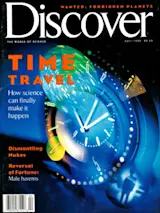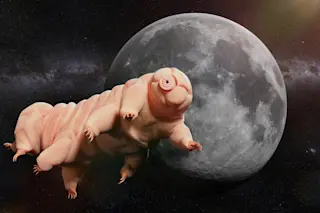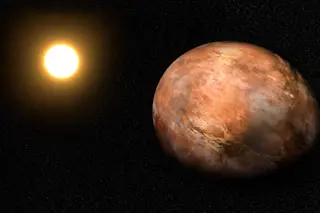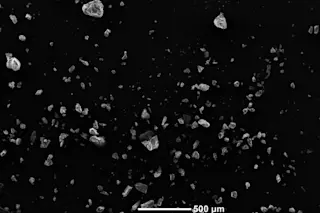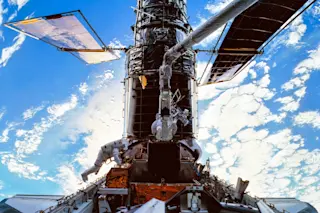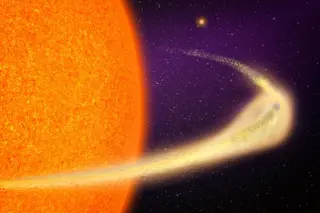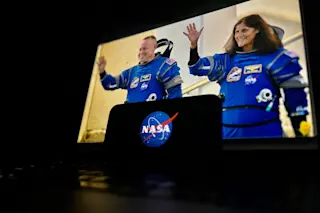The solid rockets flared, and the space shuttle Columbia roared through a hole in the clouds toward the heavens. Inside the crew cabin the sudden acceleration to 17,000 miles per hour slammed Drew Gaffney back into his seat with a force three times that of normal gravity. He felt his pulse racing under the stress. Within minutes his neck veins began to bulge and his face puffed up, the result of a massive migration of fluids to the upper body. You feel congested, he recalls now. Not nasally congested, but cerebrally congested. It’s like there isn’t enough room in your head for your brain. Gaffney was getting his first taste of a phenomenon known in the space trade as fat-face, chicken-legs, a physiological change experienced by astronauts that has always been attributed to zero gravity. It’s a phenomenon that has fascinated biomedical researchers for years. Normally, because of gravity’s pull, blood and other body fluids in an earthbound human tend to pool in the body’s lower half. But in space the opposite occurs. Fluids tend to rise to the chest and head, giving the face a moonlike appearance, causing the legs to shrink, and bringing about critical changes in blood volume around the heart.
Unlike previous astronauts, though, Gaffney was collecting more than anecdotal evidence about the vagaries of his body fluids--he was serving as the vessel for his own experiment. The 45-year-old cardiologist was riding into space with a pack of monitoring equipment at his back and thin plastic tubing laced through his veins to within an inch of his heart.
Gaffney’s self-experiment last June was one of 18 major research projects conducted on Spacelab Life Sciences 1, the first NASA shuttle mission explicitly designed to explore how the human body behaves in space. His journey, intended to pave the way for such future long-term missions as a trip to Mars, lasted nine days. But for the opportunity to do science in space, he had waited for more than seven years--years marked by frustration, setbacks, and delays.
The idea for the experiment had originated even earlier, in 1978, when NASA first began planning a flight devoted to exploring space physiology. It was the brainchild of C. Gunnar Blomqvist, a cardiologist at the University of Texas medical school in Dallas, and one of Gaffney’s mentors. Although the fluid-shift phenomenon was well known among astronauts, much about it was still poorly understood: How large was the shift, and how quickly did it occur? How exactly did the body accommodate to it? Did the fluid redistribution affect the heart’s size and pumping ability? And just what was its role in triggering the major drop in blood volume--typically, around 10 percent--observed in returning astronauts? These questions weren’t trivial, because the way the body responds to space can cause problems for astronauts when they return to Earth.
Gaffney, who had just finished a cardiology fellowship in Blomqvist’s lab, jumped at the chance to become part of the space experiment. It was the next best thing to going up in space himself. A trained pilot, he had long been smitten with the idea of spaceflight--he had even contemplated signing up for NASA’s astronaut program. But at the time, training as an astronaut would have meant sacrificing his career as a physician and researcher, so he had given up the idea.
Over the next decade Blomqvist’s team devised several noninvasive ways to explore the fluid-shift phenomenon and its effect on the heart. Astronauts could strap on monitoring cuffs, for example, to check peripheral blood pressure and measure size changes in their limbs. They could paste on electrodes to track their heartbeat and undergo ultrasound tests during flight to measure their heart size. But a critical component of the team’s experiment was that one of the astronauts would shoot into space wearing a catheter to measure his central venous pressure--that is, the pressure inside his veins bringing deoxygenated blood back up to his heart.
Cardiologists quite routinely insert this type of catheter--a flexible fluid-filled tube connected to a blood pressure monitor--into their patients. However, the mere notion of inserting a catheter into an astronaut gave NASA engineers the heebie-jeebies. There was substantial opposition, Gaffney recalls. An invasive test like this had never been done before, and it had the appearance of inherent risk. It represented crossing a line, in terms of what was being done to humans in space. There was a feeling of: ‘If we let ’em do that to somebody, what are they going to do next?’
A way out of this impasse began to emerge in 1983 when the space agency, under its payload specialist program, opened up two positions for non-NASA scientists to carry out the Spacelab experiments. Suddenly Gaffney, by then a professor at the university medical school in Dallas, saw a chance to go into space without abandoning his academic career. What’s more, if he was picked for one of the positions, he could wear the catheter.
Nasa announced Gaffney’s selection as part of the Spacelab crew in 1984, with lift-off scheduled for January 1986. Gaffney was thrilled. Putting himself at NASA’s disposal for two years seemed a modest investment to make for the experience of a lifetime. But a succession of mechanical failures bumped Columbia from its original 1986 launch date, and the slot was filled instead by the ill-fated Challenger. That disaster took the Life Sciences Mission off the flight schedule altogether, ultimately deferring the mission for five more years.
For a biomedical researcher, space offers a unique and irresistibly glamorous environment for studying the human body. But NASA’s unwieldy bureaucracy and the huge commitment of time and money that space research entails have long caused mixed feelings among scientists. As the wait dragged on, one researcher slated for the mission dropped out. The pall cast by the Challenger explosion only added to the stress on the Columbia crew and their families.
Gaffney, the father of two girls, recalls the last words of his younger daughter before his own takeoff. NASA, he explains, had made a videotape of the astronauts’ families waving farewell at the launchpad. They play this videotape to the crew during breakfast, right before you suit up and go, says Gaffney. And I can see my younger daughter--she was ten at the time--is sort of sullen, with her arms crossed, not wanting to look up. And the man making the videotape says to her, ‘Come on, you must want to say something to your daddy.’ She looks up and she says, ‘Tell him to quit now.’
The Challenger explosion had also rekindled NASA’s queasiness about sending a man into space with a plastic tube threaded up to the entrance of his heart. Suppose an emergency occurred and lift-off had to be aborted? The concern was that somebody wearing a catheter might be encumbered and not move as fast, says Gaffney. To allay the agency’s fears, Blomqvist’s team modified the hardware to allow Gaffney complete freedom of movement. The free end of the catheter (that is, the part sticking out of Gaffney’s body and through his orange NASA suit) would connect to cables leading to monitors Gaffney would carry in a small backpack. The catheter was built with what are called quick disconnects, says Gaffney. So if you want to leave in a hurry, you just get up and the cables pop. They’re left in the seat and you’re out of there.
Despite NASA’s misgivings, Gaffney continued to maintain that the catheter procedure was perfectly routine; only the setting was unusual. Besides, wearing the tube would carry on a tradition, once strong in medicine, of self-experimentation. You ought to try things yourself, Gaffney argues, before you ask other people to do them.
Ten ... nine ... eight ...
It was 9:24 a.m. on June 5, 1991, and at last Columbia was poised upright on the launchpad, with Gaffney listening to the terminal countdown. He was strapped into his seat in the traditional lift-off position--upended on his back with his legs toward the sky. Hooked to a bracket beneath his seat was the white backpack carrying the monitoring equipment for his catheter. The tube itself snaked from the backpack up into the arm of Gaffney’s orange suit, winding its way into his chest.
The catheter had made Gaffney the media star of the crew, along with the 29 white rats and the 2,478 baby jellyfish that were also on board as experimental subjects. Waiting for lift-off Gaffney reflected that the crew had come almost this far before, only four days earlier. With just 60 minutes to go, however, that launch had been canceled when a navigational instrument failed. It was then that those quick disconnects turned out to be quite useful. Thanks to Blomqvist’s modifications, Gaffney was able to simply unsnap the catheter from its monitoring gear and walk away with the tube still inside his body, ready to plug it back in again for the June 5 lift-off.
A pair of his Dallas colleagues had put the catheter in place. After piercing a vein on the inside of Gaffney’s right elbow with a guide needle, they threaded 18 inches of tubing, about the diameter of a toothpick, into Gaffney’s body. They watched what they were doing on a video screen, with the moving picture of Gaff-ney’s chest provided by an X- ray technique called fluoroscopy.
The monitor showed the catheter’s tip entering the superior vena cava, the fat vein that sends oxygen-poor blood into the right side of the heart. The tip was carefully maneuvered into place, about an inch above the right atrium, the heart’s upper-right chamber. If left short of the mark, the catheter would give faulty readings and waste the precious opportunity to gather data; if pushed too far, it could enter the cardiac chamber and trigger an irregular heartbeat.
Once the tube was in place, the Dallas doctors capped its free end and taped it onto Gaffney’s arm. The next morning, when Gaffney got into his flight suit, his colleagues helped hook the tube to the data- recording equipment the cardiologist would wear on his back. He was all set to go when the navigational instrument failure scrubbed the flight.
Now Gaffney finally sat with his catheter rigged up and the roar of Columbia’s engines in his ears. This may sound strange, he says, but all I felt was relief. After waiting for seven and a half years, I was on my way. And nothing was going to stop me.
The human body is subjected to two quite opposite effects as it’s propelled into space. During the first eight minutes of flight, the shuttle’s rapid acceleration subjects the body to g-forces that drive it deep into the seat. But as the shuttle enters orbit, the body is suddenly released from the pressures of gravity. Inside Columbia Gaffney’s body lightened so rapidly he pressed against his shoulder strap to make sure he wasn’t about to fly out of his chair. His stomach began to churn. You feel your guts floating up, he recalls. I found myself tightening my abdomen, sort of pushing things back.
By now the fluid shift was palpable. Gaffney’s face felt inflated and he was developing a throbbing vascular headache. He checked the catheter monitor, expecting to see his central venous pressure reading soar with the rush of blood and fluid toward his upper body. A normal reading on Earth in a seated position was about six millimeters of mercury. But his showed a drop to 1.5.
Gaffney was crushed. After all these years, all the haggling to persuade NASA to allow the catheter, was he being undone by an equipment glitch? Gaffney pulled out the backup hardware and hooked it up: it read 2- -an insignificant difference. The reading was a revelation, the opposite of what everyone had expected. But it was clearly no mistake.
To add to his discomfort, Gaffney was experiencing a second phenomenon familiar to humans in zero gravity: motion sickness. He had started feeling slightly nauseated within a minute after lift-off. Space motion sickness, which afflicts at least half of all astronauts, occurs when the body’s vestibular system, located in the inner ear, is deprived of gravitational cues. As part of the mission, various experiments (involving not only humans but also the rats and jellyfish on board) were to seek a better understanding of the process. Gaffney, however, was struggling with his own personal experience of space sickness. At first he tried to get up and go about his business, to fight his nausea without aid. Finally, recognizing it was hopeless, he prepared a shot of an antinausea drug.
Just as he poked the syringe into his skin, he threw up.
Now Gaffney faced another dilemma of life in weightlessness: in space, everything floats. Learning to vomit in zero-g is not one of the things you’ll find in Miss Manners or Emily Post, he says. But there’s definitely an etiquette.
Hoping to keep its space jockeys from soiling the cabin, NASA had supplied each astronaut with what Gaffney calls an elegant barf bag-- complete with cloth upper container, plastic sack, and wet wipe for cleaning up. But technology has its limits, notes Gaffney. The problem, of course, is that the stuff doesn’t fall. It’s in your nose and your mouth. It’s really gross. Fortunately, the most acute effects of motion sickness were eased by the medication within 30 minutes; the balance of Gaffney’s symptoms disappeared over the next four days.
As he went about his work on that first day in space, Gaffney recalls blowing up like a balloon. He was the living embodiment of fat- face, chicken-legs syndrome. Yet the reading from his catheter remained consistently and mystifyingly below normal pressure readings on Earth. This would later give Blomqvist’s team plenty to chew over on the ground. But Gaffney had little time for contemplation; he was too busy in his many roles as astronaut, investigator, and research subject. As scheduled, his catheter was withdrawn nine hours into the flight, having fulfilled its purpose.
Most of the experiments took place inside Spacelab, which was stowed in the shuttle’s cargo bay. The $140 million reusable module measures 23 feet by 16 feet, about the size of a bus, and is accessible through a pressurized tunnel from the crew compartment (the astronauts commute by air, literally flying through the tunnel). For this mission the module was outfitted with the sort of equipment that might be found in any good medical school physiology lab: it included cell incubators, ultrasound and ekg machines to study heart size and function, a device to measure body mass, an exercise bicycle to assess heart and lung performance under stress, and a mass spectrometer to analyze exhaled gases.
The astronauts carried out their experiments at a relentless clip, with a daily schedule budgeted in five-minute increments. They drew blood samples to study the effects of spaceflight on different types of blood and immune cells. By inhaling tracer gases, then blowing into tubes while on the exercise bike, they provided data for lung and heart function studies. As part of the fluid-shift studies, they also rigorously logged everything they ate and drank, weighed themselves daily, and collected urine, as Gaffney puts it, on a void-by-void basis. (It’s known that when receptors around the heart sense blood volume rising, they promptly tell the kidneys to dump fluid. So it was thought that astronauts tended to urinate more in space because of the fluid shift that occurs in zero-g.)
The experiments with rats and jellyfish--involving observation during flight, tissue sampling and dissection afterward--complemented the human trials. One aim was to determine whether the animals provided a good model for human responses to weightlessness. Jellyfish, for example, were selected because their gravity sensors, similar to those in the human inner ear, might offer clues to the origins of space sickness. On Earth jellyfish swim up and float down; in their sealed plastic bags and bottles on Spacelab they moved in confused circles. Rats, observes Gaffney, didn’t seem to enjoy drifting about in their cages, either. They were happier when the humans on board took them out of their cages and cuddled them.
The crew had barely begun their laborious regimen of experiments when their lab freezers started breaking down. The freezers, needed to preserve the crew’s frozen samples of blood and urine, took turns warming up, threatening the mission with meltdown. After feverish consultation with ground experts, the crew managed to save the biological materials by shuffling them back and forth between freezers while defrosting, then restarting one machine at a time. But the round-the-clock rescue effort further cut into the increasingly weary crew’s sleep.
Even before the freezer incident, Gaffney was struck by how difficult it was to sleep. Everybody’s watched 2001, he told a medical school audience recently. You think space is quiet. Well, it’s like a boiler factory inside the shuttle. Radios, pumps, and fans produced a din of up to 75 decibels even in the relative still of night. Cabin lights were another problem. Some of the astronauts wore blindfolds when they went to bed.
After seven days in space, with the main experiments largely completed, shuttle commander Bryan O’Connor persuaded NASA administrators to give his exhausted crew a break. Space is a wonderful place to play, Gaffney says, recalling his few hours of respite. Now accustomed to their floating life-style, the astronauts stacked themselves on top of one another and performed six-layer push-ups.
Columbia’s touchdown at Edwards Air Force Base in California three days later was flawless. But the effects of the trip were far from over. For astronauts, readaptation is often traumatic--next to space motion sickness, the most debili-tating part of space travel. And it’s all the product of the fat-face, chicken-legs syndrome.
While volume depletion triggered by the fluid shift is no problem in the weightless environment of space, it can cause no end of trouble upon the return to Earth. As you might expect, Earth’s gravity reverses the fluid shift, redirecting more blood to the legs. With less blood in the body as a whole (and more of what’s available in the lower half), the heart may not always be capable of pumping enough blood up to the brain. The result is dizziness or fainting when a newly returned astronaut tries to stand (a condition called orthostatic intolerance). Muscle disuse and atrophy from the cushy life in zero-g make the transition even more difficult.
Eager to study the painful readjustment, researchers greeted the crew with an airport people mover and plucked them off the shuttle in record time; they were on their way for more testing 26 minutes after hitting the tarmac. Used to floating effortlessly about Columbia’s cabin, the astronauts now found it difficult to even rise out of their seats. It’s quite a shock, says Gaffney. The first time I pushed myself up, I felt like I was lifting three times my weight. You’re in that heavy orange flight suit, and your muscles are really weak, and you’re kind of staggering down the steps. And then you’re whisked out to the experiments. Gaffney and three other astronauts remained in California for six more days of medical testing.
The various research teams that designed the experiments aboard Columbia say it will take years to complete the analysis of all the data collected on the mission. But three months after the shuttle’s return to Earth, the principal investigators began discussing their initial findings.
To Blomqvist, Gaffney’s low central venous pressure upon entering zero gravity was a bombshell. With fluids shifting to the upper body, he expected the reading to be higher than on Earth, not lower. He now speculates that the shift actually began on the launchpad, during the cardiologist’s four-hour wait for lift-off in the legs-up, head-down position. Because Gaffney was upended, his fluids started moving to his chest, initiating his body’s efforts to reduce the increased venous pressure. Excretion was one reaction, but there may have been others. One possibility, for instance, is that Gaffney’s blood vessels dilated while waiting for lift-off. If you relax the blood vessels to make them floppier and stretchier, explains Gaffney, then you’ll still have the same amount of blood in your system but the pressure will fall. Thus some of the adaptation that’s been ascribed to space apparently occurred on Earth. By sheer fluke, it seems, the traditional lift-off position primes the human body for spaceflight.
Blomqvist’s observations, however, do fit a general pattern emerging from Columbia’s mission, suggesting that the body adapts to zero gravity far faster than anyone expected. Researchers from Baylor College of Medicine in Houston, for example, found shifts in kidney function and a drop in red blood cell production within 24 hours of lift-off. Because of fluid excretion, blood volume initially dropped by as much as 20 percent, raising the relative proportion of red cells in circulation. Researchers now think that the kidneys, sensing the blood was getting thick and sludgy with cells, sent signals to slow down red cell production.
Other experiments confirmed what had already been suspected. White blood cells, which fight infection, became less responsive. Muscles atrophied from disuse. Levels of calcium and other bone minerals declined when limbs no longer had to work against gravity. All these problems, however, gradually reversed themselves on return to Earth. NASA officials say nothing uncovered in the Life Sciences Mission suggests that humans could not survive a lengthy flight, such as a trip to Mars, though countermeasures, such as artificial gravity, may be necessary to avoid permanent damage.
His astronaut days now over, Gaffney has resumed work as a cardiologist at the medical school. Not that he wouldn’t fly again: If I had the chance to do a long-duration flight or to do different experiments or to fly with the Russians, I would go tomorrow, he says. But he and Blomqvist remain involved in planning future missions (Spacelab Life Sciences 2 is now scheduled for July 1993). Two junior members of their team have decided to apply for the payload specialist program, in the hope that, like Gaffney, they can someday conduct their own research among the stars.


